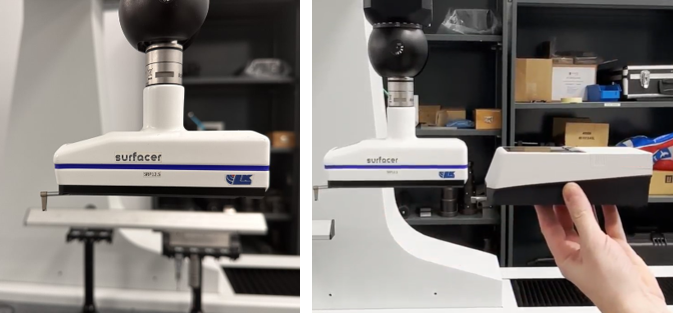In precision manufacturing, every detail counts. From a part's geometry to its surface roughness, measurement processes must be as accurate and efficient as possible.
In this context, three-dimensional roughness testers are presented as a key tool for improving both the repeatability and automation of inspections, compared to traditional manual workshop roughness testers.
How does a 3D-mounted roughness tester work?
This measuring device, using a three-dimensional coordinate system, allows for precise analysis of the surface roughness of parts.
Being mounted on a three-dimensional machine, it offers significant advantages that make it stand out compared to manual models.
Click on this video and discover how the three-dimensional roughness tester works with our metrologists.
Benefits of the Three-Dimensional Mounted Roughness Tester
- Improved Repeatability
It has the ability to perform roughness measurements at the same point every time.
This is because the part is precisely aligned and fixed on the three-dimensional system, eliminating the variations that can occur with a manual device, where accuracy depends largely on the skill and technique of the operator.
- Concurrent Measurements
Roughness measurement is performed simultaneously with the measurement of the workpiece geometry.
This enables a comprehensive analysis of part characteristics in a single pass, saving time and reducing the risk of errors when taking multiple separate measurements.
- Process Automation
It is possible to program the placement of the roughness tester by configuring a macro that defines both the positioning and the path the device must take.
This not only optimizes inspection time, but also minimizes human error and improves overall process efficiency.
Process Optimization with TouchDMIS
The software TouchDMIS allows precise control of the movements of the roughness tester.
Through the creation of specific macros, the exact measurement path can be set for each part, ensuring consistency is maintained across all inspections.
This type of programming not only optimizes inspection time, but also offers complete traceability of the measurements taken, which facilitates approval and quality control in manufacturing.
Why choose the 3D mounted roughness tester?
In summary, the integration of a three-dimensional roughness tester into the inspection process offers three essential advantages:
- Consistent and repeatable measurements.
- Reduction of inspection time and human error.
- Efficient automation that improves productivity.
By improving the accuracy, efficiency, and repeatability of roughness measurement, this system becomes an indispensable tool for process approval and quality control in the manufacturing of complex parts.
If you're looking to optimize roughness measurement in your manufacturing processes, a 3D roughness tester is the ideal solution to take your production quality to the next level.
Incorporation of the roughness tester into our catalogue
Due to the optimization that this system represents, We have decided to add the three-dimensional roughness tester to our three-dimensional machine accessories catalog.
Along with other essential components, such as styli, probe modules, fixtures, calibration spheres, heads, sensors, and reading scales, the roughness tester is integrated as an advanced solution to improve the quality and efficiency of measurement processes.
With these accessories, we offer our customers a complete range to optimize production and ensure precision at every stage of the manufacturing process.
For more information about our capabilities call us at 947 20 91 41 or send us an email to teciman@teciman.com. Follow us on LinkedIn to find out all the news.
